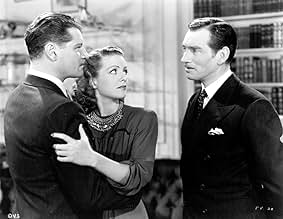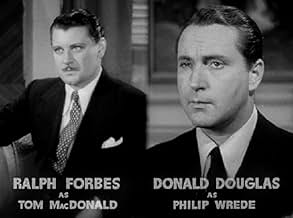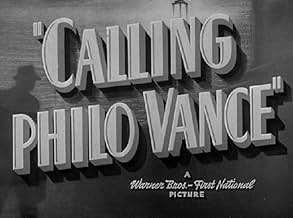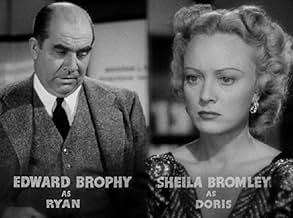AVALIAÇÃO DA IMDb
5,8/10
550
SUA AVALIAÇÃO
Adicionar um enredo no seu idiomaDespite an exclusive contract with the U.S. government, designer Archer Coe's design is being bid on by German, Japanese, and Italian agents - until he's murdered.Despite an exclusive contract with the U.S. government, designer Archer Coe's design is being bid on by German, Japanese, and Italian agents - until he's murdered.Despite an exclusive contract with the U.S. government, designer Archer Coe's design is being bid on by German, Japanese, and Italian agents - until he's murdered.
- Direção
- Roteiristas
- Artistas
Jimmy Conlin
- Dr. Doremus - Coroner
- (as Jimmy Conlon)
Wedgwood Nowell
- Brisbane Coe
- (as Wedgewood Nowell)
Herbert Anderson
- First Reporter
- (não creditado)
Henry Blair
- Hans Snauble
- (não creditado)
Egon Brecher
- Austrian Judge
- (não creditado)
- Direção
- Roteiristas
- Elenco e equipe completos
- Produção, bilheteria e muito mais no IMDbPro
Avaliações em destaque
While I do like JAMES STEPHENSON as an actor (he was excellent in THE LETTER with Bette Davis), he lacks the sort of debonair charm needed for the role of Philo Vance in CALLING PHILO VANCE. However, that's not integral to your enjoyment of this updating of "The Kennel Murder Case" which was made in '40 when the Nazis were making big strides during World War II.
Secret stolen plans for a bomber falling into the hands of German agents is the crux of the matter here, to the tune of $250,000. The story begins with Vance accepting an assignment in Vienna where he is trying to find out whether Archer Coe is selling aircraft plans to a foreign country. But the main story begins when he's deported to the U.S., escapes authorities and returns to investigate the case for Chief Investigator Markham (HENRY O'NEILL).
The wealthy household where Coe died in a locked room, is at first ruled as the scene of a suicide but soon evidence proves it to be a murder and there are several suspects--among them, RALPH FORBES, DONALD DOUGLAS and MARTIN KOSLECK, in an unusual role as a butler. Kosleck usually played German spies in all the Warner war films.
Under Stanely Clements' direction, the tale moves quickly to an all too abrupt conclusion with very little explanation given for the intricate murder plot. While not exactly plausible, it does make an interesting mystery for who-dun-it fans with some clever touches in the script.
But the main disappointment lies in not having a satisfactory actor in the Philo Vance role.
Secret stolen plans for a bomber falling into the hands of German agents is the crux of the matter here, to the tune of $250,000. The story begins with Vance accepting an assignment in Vienna where he is trying to find out whether Archer Coe is selling aircraft plans to a foreign country. But the main story begins when he's deported to the U.S., escapes authorities and returns to investigate the case for Chief Investigator Markham (HENRY O'NEILL).
The wealthy household where Coe died in a locked room, is at first ruled as the scene of a suicide but soon evidence proves it to be a murder and there are several suspects--among them, RALPH FORBES, DONALD DOUGLAS and MARTIN KOSLECK, in an unusual role as a butler. Kosleck usually played German spies in all the Warner war films.
Under Stanely Clements' direction, the tale moves quickly to an all too abrupt conclusion with very little explanation given for the intricate murder plot. While not exactly plausible, it does make an interesting mystery for who-dun-it fans with some clever touches in the script.
But the main disappointment lies in not having a satisfactory actor in the Philo Vance role.
This is an adequate afternoon B-feature that probably served more as a warning against fifth-columnists than it actually entertained anyone. It all centres around attempts by the Axis powers to obtain access to the designs of "Archer Coe" (the briefest of appearances from Richard Kipling). Now he has an exclusive arrangement with the Americans so when he is found murdered, it falls to the wily, suspicions and tenacious "Vance" (James Stephenson) to find out who the killers were and on whose malevolent behalf they were working? Did they manage to steal his secret plans? Now this is just a substantial reworking of "The Kennel Murder Case" (1933) - even down to whopping great chunks of the script being transferred, albeit updated, to allow for it's WWII scenario. Although all pretty lightweight and devoid of any real sense of jeopardy, Stephenson is actually quite engaging and there is a decent supporting effort from Edward Trophy ("Ryan") delivering some fun to this rather dry, procedural, crime drama. It's only an hour, and if you like the genre then there isn't really anything not to like - or memorable - about this.
This remake of Kennel Murder Case, The (1933) has some good points, but James Stephenson is not one of them. He plays it too impersonal for my taste and pales by comparison with William Powell, who played Vance in the original. But the screenplay, which was updated for the war that loomed on the horizon, was nicely developed, concerning plans for a warplane. The setting was switched to the State Department, with Vance an employed investigator instead of a private eye. I really enjoyed how he used diagrams to explain the movement of the people involved in the murder of the warplane designer, so that in the end, the actions of all were clear. The film also had the advantage of having Edward Brophy in the Sergeant Heath role (here he's called Ryan), bringing comedy without the stupidity of the Heath character. It was rather fun to watch.
One of the weakest Philo Vance films: a pointless remake of "The Kennel Murder Case", with a blander cast. But if you haven't seen "Kennel", you may still find the story ingenious. The then-topical WWII elements look out of place now in a Philo Vance mystery. ** out of 4.
This is a remake of the "Kennel Murder Case" with Philo Vance (James Stephenson) going after some U. S. airplane plans sold to a foreign nation; the designer of the plans and his brother both wind up murdered, and there are plenty of suspects.
William Powell was probably the best Philo Vance - he had the requisite charm. Stephenson, who started in films late in life after stage work, was on his way to a big career when he made "Calling Philo Vance" - unfortunately, he died the next year, at the age of 53.
As with "The Dragon Murder Case" with Warren William as Vance, the supporting players have the good lines and the energetic roles. Stephenson doesn't have a lot to work with, but he's okay.
Parts of this film are interesting, it's a little better than "The Dragon Murder Case," which isn't really saying much.
William Powell was probably the best Philo Vance - he had the requisite charm. Stephenson, who started in films late in life after stage work, was on his way to a big career when he made "Calling Philo Vance" - unfortunately, he died the next year, at the age of 53.
As with "The Dragon Murder Case" with Warren William as Vance, the supporting players have the good lines and the energetic roles. Stephenson doesn't have a lot to work with, but he's okay.
Parts of this film are interesting, it's a little better than "The Dragon Murder Case," which isn't really saying much.
Você sabia?
- CuriosidadesAll the scenes involving the two murdered men are taken directly from the earlier mystery called O Caso de Hilda Lake (1933), in which William Powell played Philo Vance. In both movies, most of the dialog in the scenes pertaining to the murders and the investigation is exactly the same, word-for-word, which clearly indicates that the script from the 1933 film was adapted to the story for this film, which focuses on the theft of secret aircraft plans. However, in "The Kennel Murder Case", the plot concerns stolen Chinese art objects.
- Erros de gravaçãoRalph Forbes is credited onscreen as "Tom MacDonald," but throughout the film, he is called Taylor MacDonald.
- Citações
Dr. Doremus - Coroner: [about the dead Archer Coe] There couldn't have been much of a struggle. His hair isn't even mussed.
Ryan: [Sardonically] Somebody must have blackjacked him and then combed his hair.
- ConexõesEdited from Quando a Sorte Sorri (1933)
- Trilhas sonorasI'm Happy About the Whole Thing
(uncredited)
Music by Harry Warren
Played when Vance and Ryan meet Grassi in the bar
Principais escolhas
Faça login para avaliar e ver a lista de recomendações personalizadas
Detalhes
- Data de lançamento
- País de origem
- Idiomas
- Também conhecido como
- Tres horas trágicas
- Locações de filme
- Empresa de produção
- Consulte mais créditos da empresa na IMDbPro
- Tempo de duração
- 1 h 2 min(62 min)
- Cor
- Mixagem de som
- Proporção
- 1.37 : 1
Contribua para esta página
Sugerir uma alteração ou adicionar conteúdo ausente



































